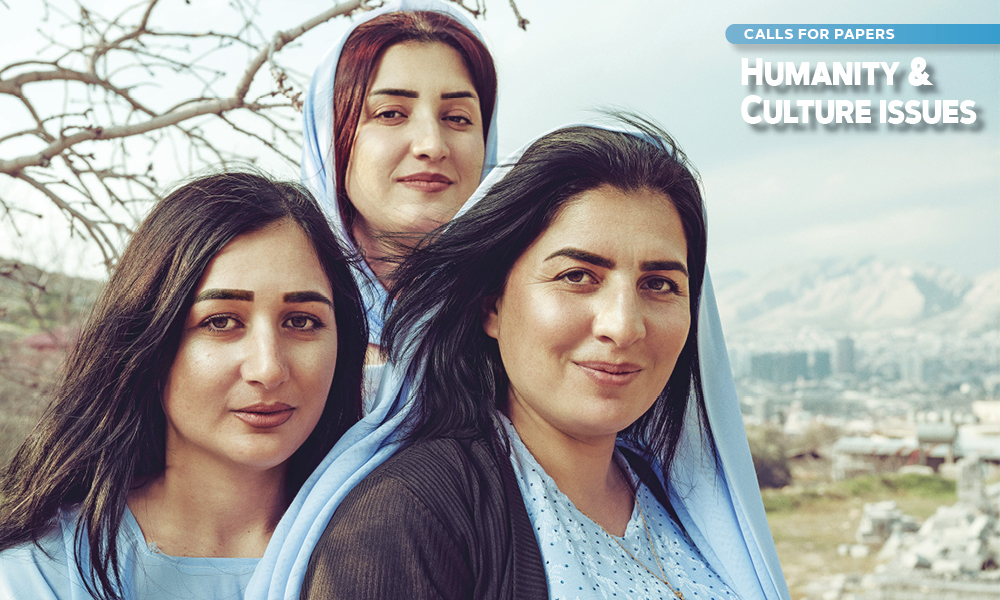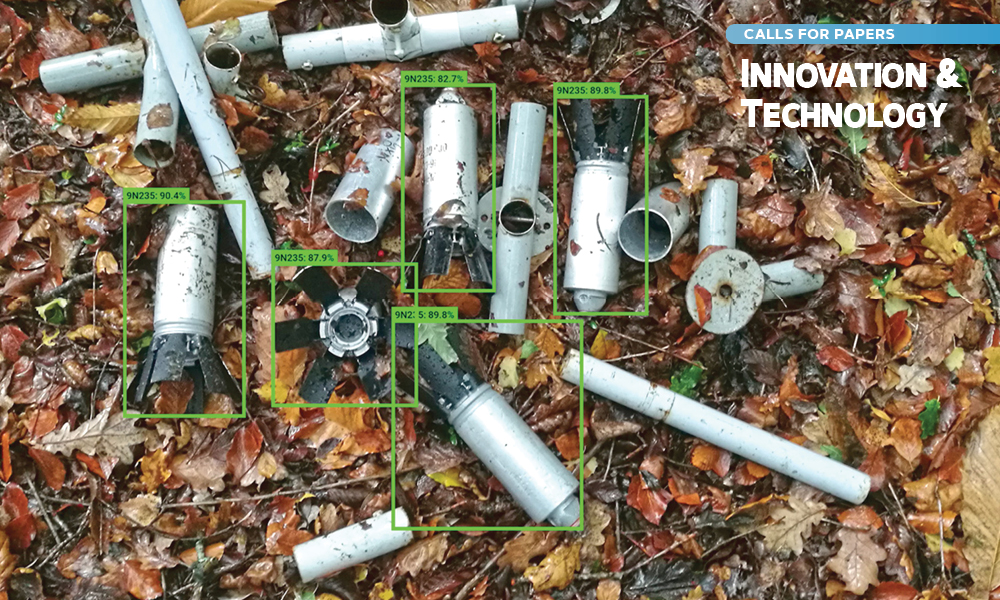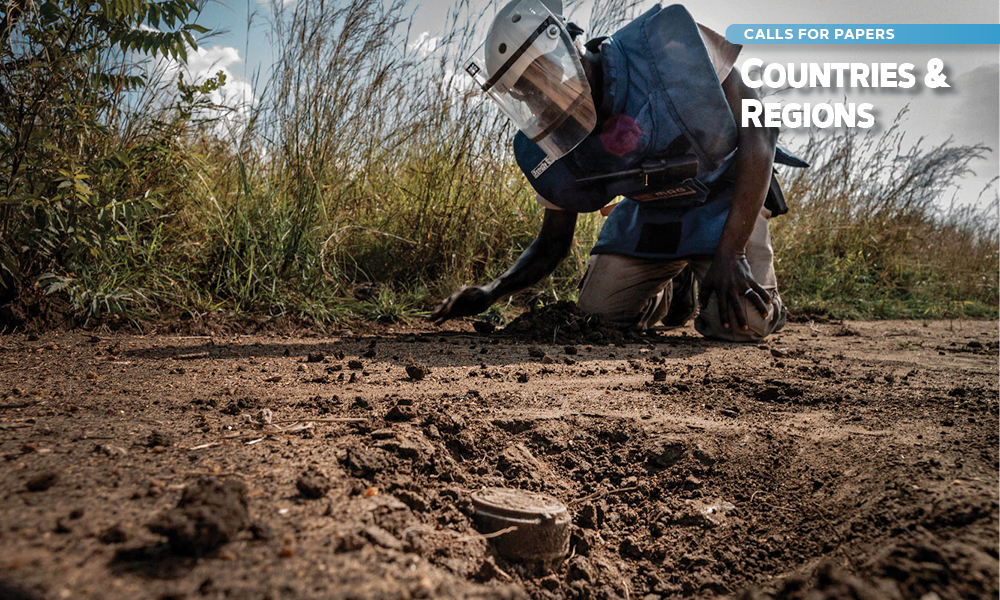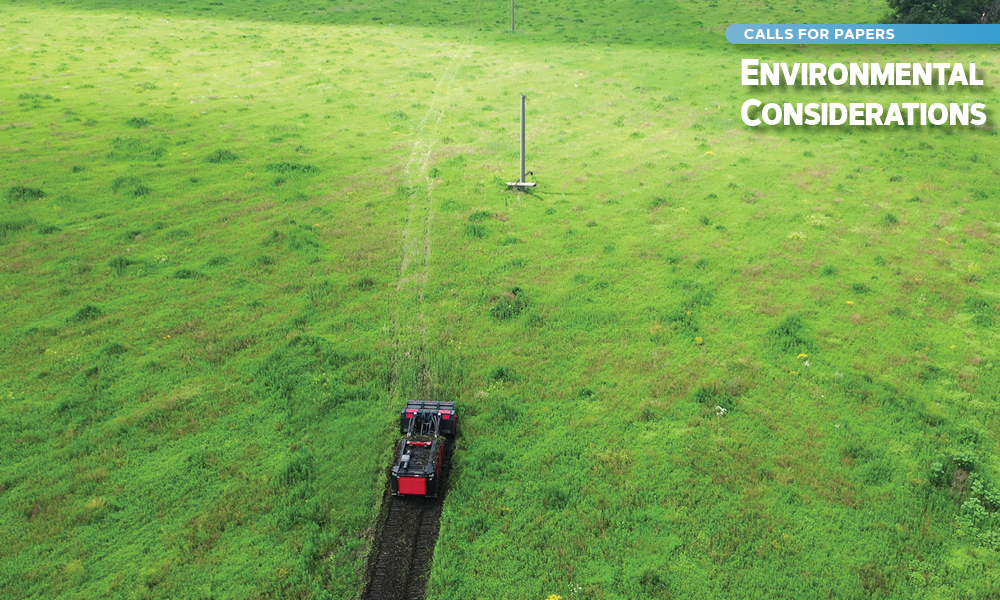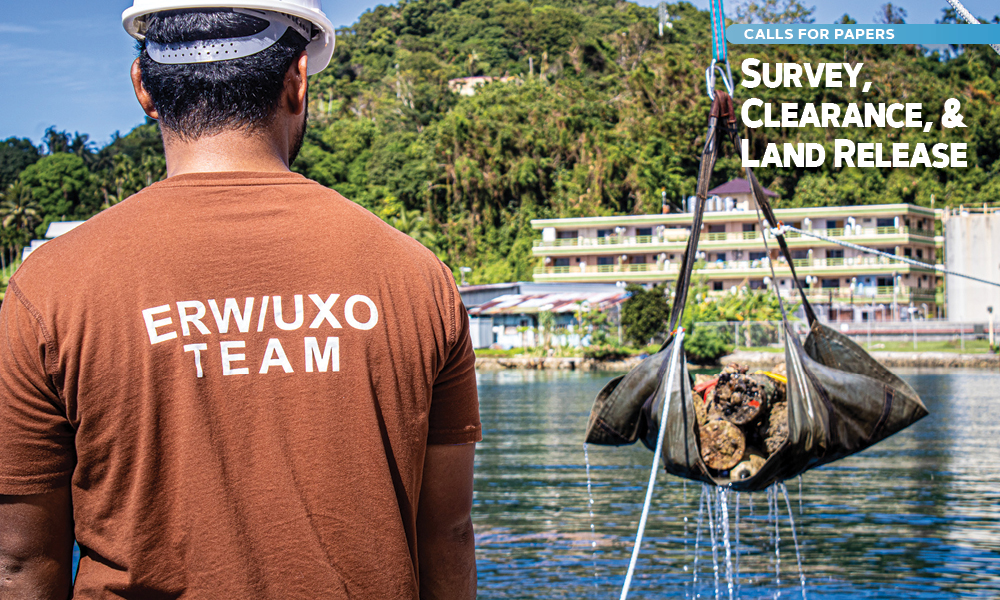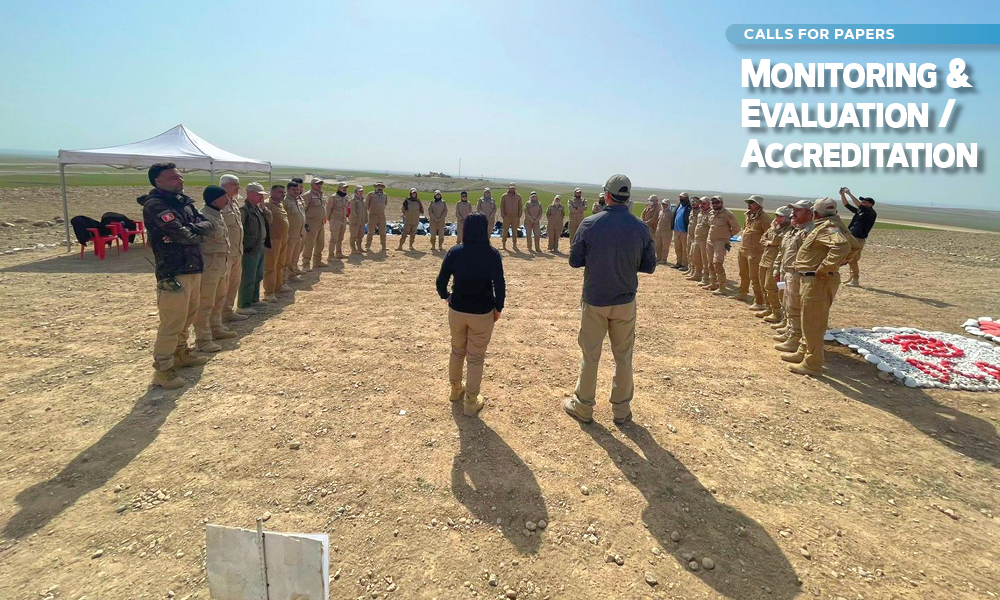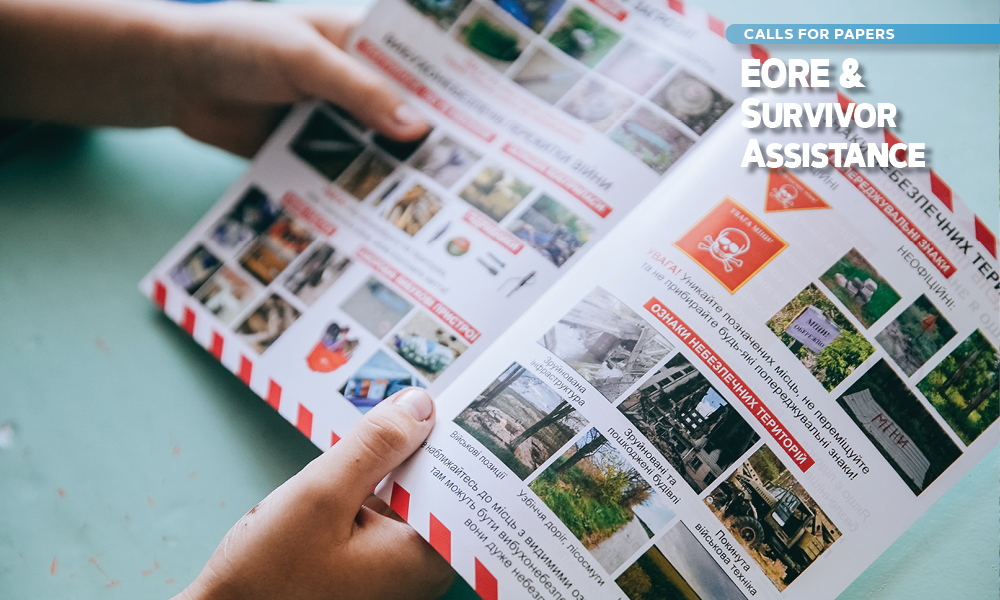Support The Journal of CWD
For 29 years, The Journal has served as the world’s leading publication that supports information exchange and disseminates research on cutting-edge technologies, operational practices, and contextual knowledge that promote excellence and integrity in the humanitarian mine action sector.
While CISR continues our work assisting in post-conflict recovery worldwide, production of The Journal of Conventional Weapons Destruction is currently suspended while we pursue new funding sources. Please check here for updates as they become available.
YOU CAN HELP!
CISR needs to raise $300,000 to continue this important work.
-
Please GIVE to The Journal! Every dollar counts.
-
Ask your organization to sponsor The Journal in exchange for acknowledgment in our publication, which reaches readers in 200 countries through 88,000 downloads annually.
-
Continue reading The Journal on the JMU Scholarly Commons.
Your donation helps improve lives.
Your tax deductible donation contributes directly to CISR supports programs that help survivors thrive in the aftermath of conflict. For more information contact CISR at cisr@jmu.edu.
Thank you!
Upcoming Topics
for The Journal of Conventional Weapons Destruction
29th Edition Topics (2025)
Mine Action and Security and Peace
Authors are invited to discuss the impact of mine action on restoring stability to post-conflict regions, and how demining efforts support economic recovery and development. The Journal invites submissions on how mine action has uniquely contributed to peace and security efforts.
Mine Action’s Role in Food Security
Food security is integral to global human security. What innovative methodologies and collaborative efforts are being employed to address the dual objectives of demining and food security, and how do these initiatives contribute to broader sustainable development goals?
Identifying Local Contexts and Needs: Importance of Community Liaison
The Journal invites submissions that explore how community liaisons are helping to tailor local mine action operations. What strategies are proving most effective in integrating local insights into broader mine action plans? How are these efforts affecting the success and sustainability of clearance operations? Articles navigating the complexities of community dynamics, as well as the challenges and successes encountered are encouraged.
Ethical Storytelling
How do we use language and imagery to represent those we support through our clearance operations, risk education, and survivor assistance? As the world sharpens its understanding of bias, ableism, and the role of powerful historical dynamics, the mine action sector finds itself at a crossroads, examining its own paradigms. How can we bring global attention to our programs and fundraising initiatives without resorting to exploitation and sensationalism? What role can the individuals and communities portrayed play in helping us to reshape not only our communications, but our relationships with those we support?
Integrating Cultural Narratives in Explosive Ordnance Risk Education
Explosive ordnance risk education (EORE) is pivotal in safeguarding communities from the dangers of landmines and explosive remnants of war. This topic invites contributions that explore innovative approaches to embedding local cultural, traditions, and storytelling methods in risk education.
Victim and Survivor Assistance
How will victim and survivor assistance evolve to reflect current, ongoing conflicts in countries such as Ukraine? How can the mine action sector bring global attention and multi-stakeholder engagement to what will be a vital component of stability and economic recovery? Articles addressing emergency care, rehabilitation, socio-economic inclusion, advocacy and accessibility, and psychological and psychosocial support for victims/survivors are encouraged.
Explosive Contamination and Children
Children living in Afghanistan, Iraq, Syria, Ukraine, and Yemen are particularly vulnerable to unexploded ordnance (EO) and explosive remnants of war. How is risk education being adapted for children in these areas and how is the mine action sector planning to provide survivor assistance to child survivors of EO in these conflict areas?
Digital Accessibility
How accessible are digital explosive ordnance risk education programs and materials? In what innovative ways is the sector working to make risk education more accessible and inclusive, ensuring it benefits a wider audience?
Drones and NTS in Conflict Areas
Drones are increasingly used in non-technical survey (NTS) to assess and map mine-contaminated areas, especially in active conflict zones. The Journal invites discussions on how drone technology is being integrated into NTS and its effects on mine action strategies. What are the advantages and limitations of using drones in this capacity, and how are they transforming the landscape of conflict area assessments? Contributions may also consider the ethical implications and future potential of drones in mine action.
Augmented Reality in EOD
How is augmented reality (AR) technology transforming the field of explosive ordnance disposal (EOD) in terms of education, risk assessment, and operational efficiency? The Journal invites contributions that delve into AR’s broad implications for enhancing safety measures in mine action?
New Technology in Ukraine
The Journal welcomes articles about the latest technology, including demining training tools, UAVs, AI, etc., that is or will be employed for survey, clearance, and training in Ukraine.
Advancing Mine Action through Technological Innovations
The Journal invites articles exploring the latest innovative approaches to using remote sensing and advanced survey techniques to identify explosive hazards.
Personal Protective Equipment
The Journal invites submissions that explore innovative advancements in personal protective equipment (PPE) for mine action. Articles may consider technological enhancements in materials, gender considerations, and design adaptations for increased effectiveness against specific hazards such as high-velocity fragmentation.
Developing Advanced Training Aids and Scenarios
Training is a critical component of mine action, ensuring the safety and effectiveness of operations. The Journal invites articles that detail the development of advanced training aids and realistic scenarios. What new tools and methods are enhancing the training of demining personnel, especially in active conflict environments? Authors are invited to share their analysis of current training technologies, the pedagogical approaches behind scenario design, and the outcomes of enhanced training practices.
Ukraine
Ukraine and the Environment: The Journal welcomes articles addressing the environmental consequences and the direct civilian and economic impact of explosive ordnance (EO) on Ukraine’s agricultural fields (food security) and the risks to critical infrastructure (power plants, oil depots, water/sewage systems, dams, etc.). How is our community uniquely poised to assist Ukraine in mitigating the extensive environmental effects of EO in Ukraine? What have we already learned and what challenges lie ahead?
New Technology in Ukraine: The Journal welcomes articles about the latest technology, including demining training tools, UAVs, AI, etc., that is or will be employed for survey, clearance, and training in Ukraine.
Middle East and North Africa
Iraq, Syria, Yemen, and Libya continue to face contamination from improvised explosive devices, explosive remnants of war, and landmines, causing a significant number of casualties, fueling instability, and impeding post-conflict and economic recovery. The Journal welcomes articles addressing survey and clearance, survivor assistance, risk education, and capacity development.
The Pacific and WWII UXO Clearance
Decades after World War II, unexploded ordnance (UXO) continues to endanger lives in the Pacific. How are current mine action operations addressing these persistent threats? This topic seeks to explore the advances and ongoing challenges in clearing WWII bombs from the Pacific, including efforts to preserve the environment. What strategies are proving effective, and how do these efforts respect and protect the storied landscapes of the region? Contributions may discuss technological advancements, policy frameworks, and local collaborations aimed at mitigating the dangers of these remnants
Ukraine and the Environment
The Journal welcomes articles addressing the environmental consequences and the direct civilian and economic impact of explosive ordnance (EO) on Ukraine’s agricultural fields (food security) and the risks to critical infrastructure (power plants, oil depots, water/sewage systems, dams, etc.). How is our community uniquely poised to assist Ukraine in mitigating the extensive environmental effects of EO in Ukraine? What have we already learned and what challenges lie ahead?
Mine Action’s Role in Food Security
Food security is integral to global human security. What innovative methodologies and collaborative efforts are being employed to address the dual objectives of demining and food security, and how do these initiatives contribute to broader sustainable development goals?
Landmine Clearance and its Environmental Impact
Expanding the scope of environmental rehabilitation, mine action efforts are pivotal not just for safety but for community and ecological revival. The Journal welcomes articles that explore the comprehensive impact of demining on the restoration of land and how this critical work aligns with the recovery of local economies and ecosystems. How has land clearance facilitated agricultural recovery, enabled the return of wildlife and biodiversity, and contributed to water conservation efforts? Contributions may also examine innovative demining technologies and strategies that minimize ecological disruption or analyze the challenges and successes in integrating mine action with environmental policy.
Underwater Clearance
Unexploded ordnance (UXO) contamination from wars and recent conflicts disrupts fishing activities, exports, cargo and container ships, water treatment plants, and affects food security. The Journal seeks articles on how programs are countering underwater UXO contamination. Additionally, we invite discussions on the environmental implications of underwater clearance.
Mitigating Contamination Displacement Due to Flooding/Extreme Weather
As climate change and extreme weather exacerbates the risk of unexploded ordnance (UXO) displacement due to flooding and landslides, The Journal invites submissions on organizations that have worked to survey and clear areas affected by UXO displacement. What preemptive strategies and frameworks are being developed to combat contamination displacement? How does integrating climate science into mine action planning enhance operational preparedness?
Active Conflicts and the Role of Mine Action
The year 2023 has witnessed the most active conflicts since WWII. Mine action plays a vital role in the many branches of post-conflict recovery. What are the unique and timely challenges faced by mine action operators in countries with ongoing conflict? The Journal seeks articles on the specific challenges being encountered and managed by mine action organizations, from clearance in rubble and heavily populated areas to the more long-term challenges of survivor assistance, environmental contamination, and funding initiatives amidst an increasing need.
Landmine Clearance and its Environmental Impact
Expanding the scope of environmental rehabilitation, mine action efforts are pivotal not just for safety but for community and ecological revival. The Journal welcomes articles that explore the comprehensive impact of demining on the restoration of land and how this critical work aligns with the recovery of local economies and ecosystems. How has land clearance facilitated agricultural recovery, enabled the return of wildlife and biodiversity, and contributed to water conservation efforts? Contributions may also examine innovative demining technologies and strategies that minimize ecological disruption or analyze the challenges and successes in integrating mine action with environmental policy.
Practical Guidance for Battle Area Clearance
The complexity of explosive remnants from global conflicts necessitates the development of advanced battle area clearance (BAC) techniques. The Journal seeks articles that explore the integration of cutting-edge technologies in BAC—ranging from robotic systems to geospatial data analysis. How are these innovations enhancing the effectiveness and safety of clearance operations? What are the benchmarks for assessing the effectiveness of these technologies, and how can their impact be measured? What strategies can be employed to ensure that these innovations meet community standards and contribute to sustainable clearance efforts?
The Pacific and WWII UXO Clearance
Decades after World War II, unexploded ordnance (UXO) continues to endanger lives in the Pacific. How are current mine action operations addressing these persistent threats? This topic seeks to explore the advances and ongoing challenges in clearing WWII bombs from the Pacific, including efforts to preserve the environment. What strategies are proving effective, and how do these efforts respect and protect the storied landscapes of the region? Contributions may discuss technological advancements, policy frameworks, and local collaborations aimed at mitigating the dangers of these remnants while honoring the cultural and historical significance of the affected areas.
Confronting New IED Threats
How is the mine action sector meeting the challenges posed by the increasing prevalence of improvised anti-personnel mines? This topic seeks to explore adaptive strategies and the vital role of knowledge sharing in effectively countering new IED threats. Submissions might address the latest technological advancements, collaborative efforts across global platforms, and the ongoing refinement of tactical responses that enhance both safety and efficacy in demining operations.
Clearing Legacy Contamination
East Asia and the Pacific continues to face contamination from landmines, explosive remnants of war, and munitions from WWII, the Vietnam War, and the Indochina Wars. Articles addressing contamination affected by populations moving into previously uninhabited areas and weather-related issues are encouraged.
Clearance and Missing Persons
The Journal seeks articles on mine action programs that have, or will in the future, work to identify, secure, and/or remove unexploded ordnance, specifically aiding humanitarian organizations in their search for missing persons or potential exhumation of human remains in countries such as Syria and Ukraine.
Future Frontiers for MDDs in Mine Action
The Journal invites articles discussing the capabilities and challenges of employing mine detection dogs (MDDS) across various regional, environmental, and contamination settings. Contributions may explore the latest innovations in MDD training techniques that enhance detection accuracy and efficiency, and the incorporation of technologies such as drones or wearable sensors to expand the operational capabilities of MDD teams.
Explosive Weapons in Populated Areas
As urban conflicts intensify, the use of explosive weapons in populated areas presents profound challenges, exacerbating humanitarian crises and hindering post-conflict recovery. The Journal invites articles exploring survey, clearance, and risk education programs that are reducing the impact of explosive weapons on civilian populations.
Underwater Clearance
Unexploded ordnance (UXO) contamination from wars and recent conflicts disrupts fishing activities, exports, cargo and container ships, water treatment plants, and affects food security. The Journal seeks articles on how programs are countering underwater UXO contamination. Additionally, we invite discussions on the environmental implications of underwater clearance.
Mitigating Contamination Displacement Due to Flooding/Extreme Weather
As climate change and extreme weather exacerbates the risk of unexploded ordnance (UXO) displacement due to flooding and landslides, The Journal invites submissions on organizations that have worked to survey and clear areas affected by UXO displacement. What preemptive strategies and frameworks are being developed to combat contamination displacement? How does integrating climate science into mine action planning enhance operational preparedness?
Mine Action and Clearance of Heritage Sites
Cultural heritage sites bear invaluable historical and cultural significance but often fall victim to the hazardous presence of explosive remnants of war. How can the mine action sector adapt its initiatives to value and protect these vulnerable sites? In contexts like Ukraine, where cultural heritage contends with unexploded ordnance amidst ongoing conflict, what unique challenges arise and how might they be addressed?
Monitoring & Evaluation: Accountability and Transparency in Mine Action
Why be transparent? As global efforts intensify to clear mines and unexploded ordnance (UXO), programs must be able to openly discuss challenges and expectations with stakeholders. How does the community effectively communicate the issues facing implementing partners while meeting reporting requirements? The Journal invites submissions on best practices in enhancing transparency and accountability in mine action. Contributions should explore how different monitoring mechanisms or data collection methods impact project implementation.
Managing the Accreditation Process in Mine Action
To safely and effectively complete demining tasks, organizations must demonstrate their ability to carry out a variety of action activities to community standards. The Journal invites authors to examine the challenges of managing the accreditation process and assessing the individual competencies needed to perform mine action tasks. How do organizations determine if their operators have the sufficient knowledge and skill to conduct relevant activities? What methods can help identify and correct discrepancies to avoid prospective issues? And how should the process integrate into a wider quality management system for future monitoring?
Integrating Cultural Narratives in Explosive Ordnance Risk Education
Explosive ordnance risk education (EORE) is pivotal in safeguarding communities from the dangers of landmines and explosive remnants of war. This topic invites contributions that explore innovative approaches to embedding local cultural, traditions, and storytelling methods in risk education.
Victim and Survivor Assistance
How will victim and survivor assistance evolve to reflect current, ongoing conflicts in countries such as Ukraine? How can the mine action sector bring global attention and multi-stakeholder engagement to what will be a vital component of stability and economic recovery? Articles addressing emergency care, rehabilitation, socio-economic inclusion, advocacy and accessibility, and psychological and psychosocial support for victims/survivors are encouraged.
Explosive Contamination and Children
Children living in Afghanistan, Iraq, Syria, Ukraine, and Yemen are particularly vulnerable to unexploded ordnance (EO) and explosive remnants of war. How is risk education being adapted for children in these areas and how is the mine action sector planning to provide survivor assistance to child survivors of EO in these conflict areas?
Digital Accessibility
How accessible are digital explosive ordnance risk education programs and materials? In what innovative ways is the sector working to make risk education more accessible and inclusive, ensuring it benefits a wider audience?
Interested in Submitting on Something Else?
We encourage authors to submit content most relevant to their work. If you are interested in submitting on a particular topic but don't see it listed here, reach out to our editorial team. We are always happy to discuss scope, submission guidelines, and deadlines.


